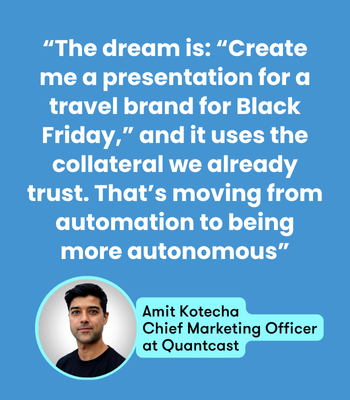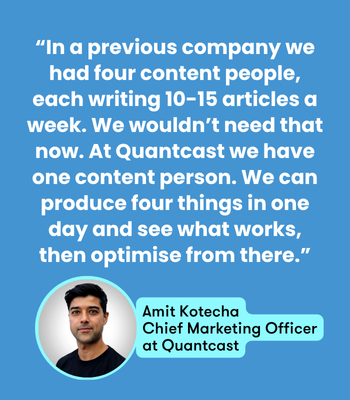From Agents to Outcomes: AI Fluency with Amit Kotecha
4th Nov 2025
In the fourth and final feature of Pivotal’s AI Series, Amit Kotecha, previously Chief Marketing Officer at Quantcast, discusses what meaningful AI use looks like inside a modern marketing org, how he thinks about assessment, and why the real step-change is moving from automation to autonomy.
How central is AI to your team’s work today – and when hiring, do you formally assess it?
Amit: I’d say for all of us, it’s about 50% of our day in an AI tool now. We don’t measure AI fluency in a quantitative way; it’s anecdotal and qualitative. I’ll ask how candidates use AI in their day-to-day job, and how they see it impacting marketing. I’m looking for examples, but it’s broad.
If you were to add a more practical test for marketers, what would you want to see?
Amit: Where we’ve found it really useful is Google’s Agentspace across our team. We’ve had it for four weeks and it’s been a game changer. We can create banks of what good looks like – collateral that’s vetted and brand-safe – and you can query that and create whatever you want. The dream is: “Create me a presentation for a travel brand for Black Friday,” and it uses the collateral we already trust. That’s moving from automation to being more autonomous. I’d be wanting to test that, where does that brain go? The same for demand generation: always-on nurture flows that learn without you having to manually change things all the time. It’s interesting how you can combine tools to be more autonomous. I’d be testing that rather than just the automation side.

We’ve been looking at Zapier’s AI fluency levels as one way to frame capability. Does that resonate?
Amit: Most people I speak to are at the capable stage; they can give good examples of day-to-day use and research. When you get to Level 3, which is adaptive, it’s about ROI, and that’s where people struggle – how has it helped me drive more leads or deliver more revenue? Our sales team has more tangible use cases. They use Notebook LM a lot now: for global clients, all information goes into a notebook; if you’re meeting for a QBR (quarterly business review) or grabbing coffee, you can query it. That has been the biggest game changer for us. We’ve won new business because of that. In marketing, it’s harder to give ROI use cases. We have good lead-gen examples with nurture tracks. We’ve tried AI on our website, but it’s not yet adaptive. All content we create is in collaboration with AI. I could quantify impact, how many pages have driven leads and new business – but I’d love that to be part of our interview process.
Beyond capability levels, what has AI changed about team design and performance for you?
Amit: Our business has grown 20% in terms of people in the last 18 months and the marketing team has not grown. We don’t need to because we’re doing our work in a much more efficient way. We’ve spent more budget on software. We use a bunch of tools we wouldn’t have used two years ago, and we’re connecting them to create more workflows. It also helps us communicate better with the rest of the business.
We now get a good portion of website traffic from AI and it converts higher than search. We’re putting more focus into what works there, but we don’t have a playbook yet. We relaunched our website in May ’24, so we’ve now got a good year of data. Signals are coming through. We’ve automated the help centre, FAQs, and case studies so they’re all query-based, and that reduced inbound queries from the commercial team. Next up is agent space for decks. Making decks is relentless. If that works, we won’t reduce headcount, but we won’t need to increase headcount as sales scales. That’s the ROI: increased performance and efficiency without adding more marketers globally to support hundreds of salespeople.
Some leaders worry AI will compress junior opportunities. What are you seeing with early-career talent?
Amit: I’m finding that more junior team members are coming up with more innovative initiatives to automate current tasks. My big thing is: don’t just automate, try to make the workflows run themselves so you don’t have to touch them. They’re coming up with better ideas. I’d love to have a lot of interns and junior folks coming in; train them up, and they’ll teach us how to do our jobs again.
What’s changed is we don’t need as many content people or as many product marketing folks. The product marketers we need are great at translating technical into simple, that’s the skill set. Go-to-market is a massive skill. AI complements product marketers. Some product marketers were purely content: one-pagers, packages for sales. Seasonal stuff you can create in a couple of hours now. We haven’t scaled product marketing as much because of AI. In a previous company we had four content people, each writing 10–15 articles a week. We wouldn’t need that now. At Quantcast we have one content person. We can produce four things in one day and see what works, then optimise from there. Our content person probably spends 75-80% of her day in an AI tool.

Which tools are proving most useful for you personally?
Amit: Gemini is integrated across the business, great for calls and notes. Notebook LM is the biggest game changer for me: you create your own world and query it. We’ve now got agent space included and I’m sure that will transform things. For marketing work I still use ChatGPT, but for creating content I’ve found Claude better, more personable tone. Claude’s got all my docs and projects, with tone of voice saved, so I use it all the time.
How do you approach the ‘try everything’ temptation versus being disciplined about the tech stack?
Amit: We’re conscious about how many tools we onboard, everything needs a business case. But I’m keen for my team to put things on my card and try them, then explain to the team. Every month in our marketing all-hands, people present new tools they’re testing and how they’re using AI. We also have a Slack channel where people share every Friday: “Here’s how I used AI this week.”
What’s worked to encourage adoption without overwhelming people?
Amit: Six months ago we ran a hackathon. Everyone could work on any AI project with any tool. We threw chaos at the company to see what happens, dozens of projects came out of it across HR, finance, everywhere. Presenting those back got people excited, “I didn’t know it could do that.” With Gemini we ran weekly drop-in workshops for anyone, and adoption is growing month over month. Some teams adopt faster than others, but it’s moving.

Finally, do you think AI proficiency becomes essential to being a great marketer?
Amit: Yes, and I think in the future we’ll stop talking about AI as something you add to your job description. It will just be part of it. We should be testing people on their marketing competency. It will level out, but it’s essential, you can’t not have it in your life now. Even as a consumer. My dad uses ChatGPT every day. If that’s your consumer, and you’re selling to him, you need to know how he behaves. As a marketer, that’s our job. You’ve got to use AI.
If you’re hiring for AI-capable teams and want a structured way to assess it, download Pivotal’s AI Fluency Hiring Frameworks (Marketing, Growth, Creative) featuring scorecards, core questions, and red flags you can use at interview today.